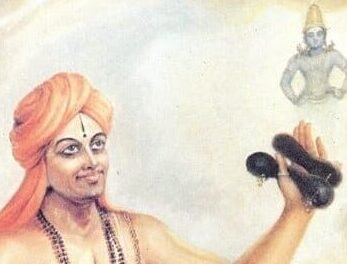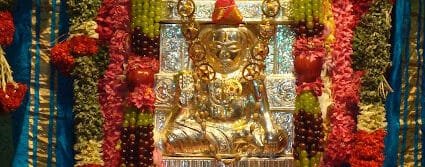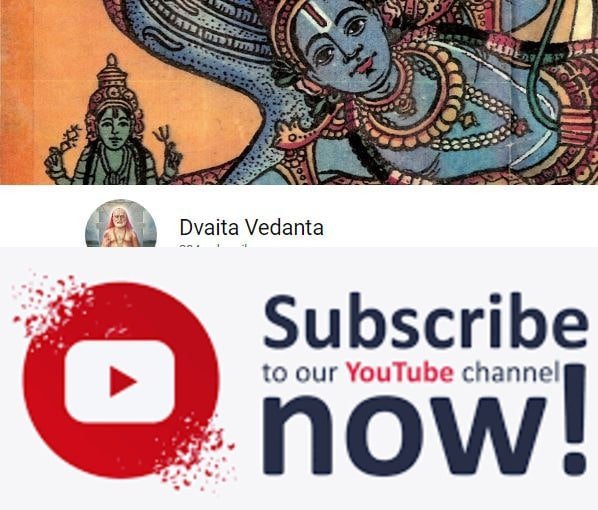|| Hari Sarvothama Vayu Jivothama ||
————————————————————-
Guru Gunasthavana (Part 3)
————————————————————-
Namaskara to all Haribhakthaas.
Sloka 7
Maayaatantraamararismayamapanayato madhvasiddhaantanaamno
netraaneevatrayopithrijagathi nrharerindhate yatprabandhaah |
Yadvagadvaithavidytaachalakulishapraudimaadaukate sah
sreyobhooyo vidadhyaatsumahitamhimaasamprati vyaasaraajah || 7
Meaning:
A prayer is now addressed to the great Vyaasaraaja Gurusaarvabhauma.
May Sri Vyasaraja who is famous for his ratnatraya (Taatparya Chandrika, Nyaayaamrita and Tarkataandava) which resemble the three glowing eyes of Sri Narahari in the garb of Dvaita Siddhanta in obliterating the arrogance of Hiranyakashipu the foe of the gods who declared himself as god, as a Vajraayudhaa or the thunderbolt of Indra which could smother the Advaitic mountains, take compassion on me and bless me here and hereafter.
In this verse the upameyam is the three works of Vyasaraja tirtha and the upamanam is the three eyes of Sri Narasimha. Since the upameyam does also the work of upamanam it is a case of Ubhaya saadaarana dharma. Though the upameyam and upamanam are similar in action but are different entities it is a case of Poorna upamam which leads to Arthaalankaaraa.
Netrena trayopi is a case of Anupraasaa alankaaraa.
Shloka 8
Chaaturyairkaakrutiryaschaturadhikashatagrantharatnapraetha
dhootaaraati prabandah sfutaviditachatuh shashti vidyaavisheshah |
soyam nah srisurendravrativaratanayodvaitashaivaasahishnoh
pushnaatu sri jayeendraadrastribhuvanaviditah saratantrasvatantrah || 8
Meaning:
The poet proceeds to offer obeisances to the Chatushashtih Kalaa Purna, Sri Vijayeendraru. Sri Vijayeendra tirtha who has to his credit one hundred and four wonderful books which are effective in opposing other shastras and establishing Tatvavada, who is a master of the sixty four arts like music, crafts, dance, idol making and the like, who staunchly opposed the Saiva and Advaita religions, who suceeded to the pontificate after Sri Surendra tirtha, who is a sarva tantra svatanra (do not need external help to know other sidhantaas) and famous in the three worlds, may be pleased to take care of us.
It is said that the Saint used to carve within half an hour a Udupi Krishna idol and present it to some lucky devotee. The Saint had written 104 works superseding Appayya Diskhitar who had written 103 works. Here the ashrama guru of the Saint, Sri Surendra tirtha who was known for his penance and Bhoo pradakshina is very much honoured.
The verse is decorated by Roopalankaara while describing the Chaaturyaa of Sri Vijayeendra tirtha and the metre is Sraghdara metre.
Shloka 9
vyaadutavadya hrudtaamitha kruthi rachanacharu chaaturya hrushyat
karnatakshonipaala pratipadarachita aneka ratnabhishekaha |
patrisharooda lakshmipathi padanalinodh agrolamba leelo
vikhyatah srisudheendra vratipatiratulam bhadram unnidhrayen naha || 9
Meaning:
Sri Sudheendra Teertharu who is the personification of fame and story and also has the blessed capacity of being the another of blemishless and wonderful granthas like “sahityasamrajya” and the like had been honoured by the king (many kings) of Karnataka by the performance of Ratnabhisheka (showering of priceless gems) not once but in several occasions. The hallowed saint is compared to a bee that hovers around the feet of “Patrisharooda” (the Lord and his Consort on top of Garuda). Sri Vadeendra prays that such a holy saint may be kind enough to bless us with all auspicious merits.
Vishesha Artha:
The saint was well versed in the shaddarshana (Sankhya, Yoga, Nyaya, Vaiseshika, Purvamimaamsaa and Uttaramimaamsa) and hence called as Shaddarshanacharya. Since he was the recipient of various gifts and titles from a plethora of kings he was also addressed as Rajamanya. The poet says that His Holiness had composed Sahitya Samrajya and other works. Some of them are Sadyulesi Ratnavali (on Tarka tandava of Vyasaraja Teertha), Sutra Pradipa (on mimamsa). 2 books on Alankara (Alankara manjari and Nikhasa) and a nataka called Subadra parinaya and Dayalu Shatakam (a stotra). The saint had also written a lucid commentary on the Bhagavata Purana (2nd and 11th skanda).
The Gwalior Maharaja, Raghunatha Bhoopala Nayaka of Tanjavur and the Vijayanagara Samrat has accepted His Holiness as their Rajaguru. and the former had conffered the title “Digvijaya Simhasanaadeeswara”.
Apart from writing many works His Holiness used to do elaborate puja to the holy dieties and idols of the matha and the Visraha used for His upasana (Garuda vahana Paramaathma) can still be seen adorning the residue of idols of Rayara matha. Last but not the very least His Holiness cannot be afforded to be forgotten because he was the most fortunate and blessed saint to have ordained Mantralaya Mahaprabhu Gurusarvabhouma Sri Raghavendra Teertha into sainthood and gave the whole world the Kaliyuga Kalpataru.
[contd…]
Dr. B. Basker
————————————————————-





Om harivaayuguruve namah